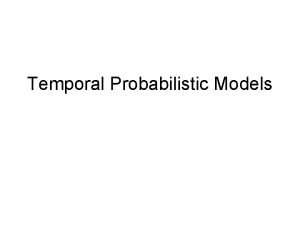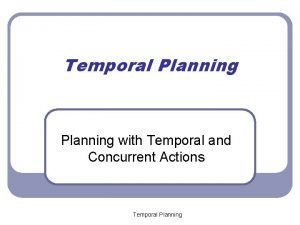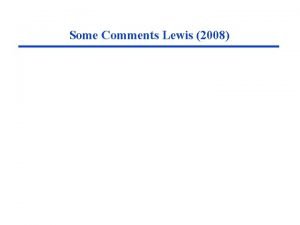Issue 326 Temporal entities Some comments Issue 326





- Slides: 5

Issue 326 Temporal entities Some comments Issue 326: Temporal entities, to be discussed at the 38 th CIDOC CRM and 31 th FRBR CRM meeting Christian-Emil Ore

CRM top hierarchy and space&time 1 E 1 CRM Entity Exx Observable Entity E 2 Temporal Entity E 52 Time-span P 4 has time-span (1, 1: 1, n) E 92 Spacetime Volume P 160 has temporal projection (1, 1: 1, 1) E 53 Place E 54 Dimension P 161 has spatial projection (1, n: 1, 1) E 77 Persistent Item I 6 Belief E 3 Condition State E 4 Period E 18 Physical Thing • The cardinality of P 4 has time-span is (1, 1: 1, n), that is, two or more instances of E 2 Temporal Entity can “share” an instance of E 52 Time-span. This was introduced in an early stage to model simultaneity. • This way of modeling simultaneity is considered obsolete and the cardinality of P 4 should be (1, 1: 1, 1) • E 2 Temporal Entity and E 52 Time-span in an one to one relation • E 2 Temporal Entity and E 92 Spacetime Volume in an one to one relation.

CRM top hierarchy and space&time 2 E 1 CRM Entity Exx Observable Entity E 2 Temporal Entity E 52 Time-span P 4 has time-span (1, 1: 1, 1) E 92 Spacetime Volume P 160 has temporal projection (1, 1: 1, 1) E 53 Place E 54 Dimension P 161 has spatial projection (1, n: 1, 1) E 77 Persistent Item I 6 Belief E 3 Condition State E 4 Period E 18 Physical Thing • The cardinality of P 4 set to (1, 1: 1, 1) has the following consequences • E 2 Temporal Entity and E 52 Time-span in an one to one relation • E 2 Temporal Entity and E 92 Spacetime Volume in an one to one relation. • P 4 (1, 1: 1, 1) and P 160(1, 1: 1, 1) make E 2 Temporal Entity, E 52 Time-span and E 92 Spacetime Volume isomorphic and they could be seen as one single class • All instances of subclasses of E 2 Temporal Entity have a spatial component.

CRM top hierarchy and space&time 3 E 1 CRM Entity Exx Observable Entity E 2 Temporal Entity E 52 Time-span P 4 has time-span (1, 1: 1, 1) E 92 Spacetime Volume P 160 has temporal projection (1, 1: 1, 1) E 53 Place E 54 Dimension P 161 has spatial projection (1, n: 1, 1) E 77 Persistent Item I 6 Belief E 3 Condition State E 4 Period E 18 Physical Thing • Have all instances of possible subclasses of E 2 Temporal Entity a spatial component? • If yes then E 4 Period equals E 2 Temporal Entity • If no then the cardinality of P 160 has temporal projection should be adjusted to (1, 1: 0, 1) • It is doubtful that I 2 Belief (CRMInf) has a spatial component. The function of an instance of I 2 Belief is to express the temporal extent of the some actor’s belief that an I 4 Proposition Set has an I 6 Belief Value.

Case: There exist instances of E 4 Temporal Entity without spatial component E 1 CRM Entity Exx Observable Entity E 2 Temporal Entity E 52 Time-span E 92 Spacetime Volume P 160 has temporal projection (1, 1: 0, 1) E 53 Place E 54 Dimension P 161 has spatial projection (1, n: 1, 1) E 77 Persistent Item I 6 Belief E 3 Condition State E 4 Period E 18 Physical Thing • Merge E 2 Temporal Entity and E 52 Time-span into one class • All instances of E 92 is connected to one and only one instance of this new class through P 160 has temporal projection which is an injection. Thus E 92 could have been a subclass of the new class. At least for pedagogical reasons this maynot be a good idea • Is this a possible solution?









